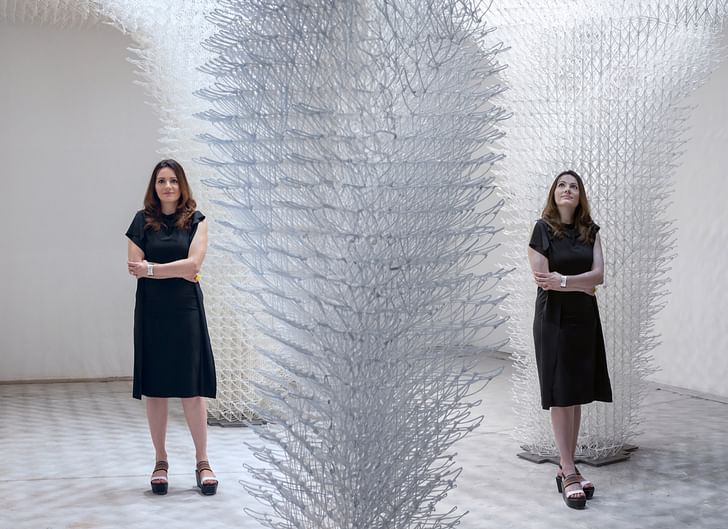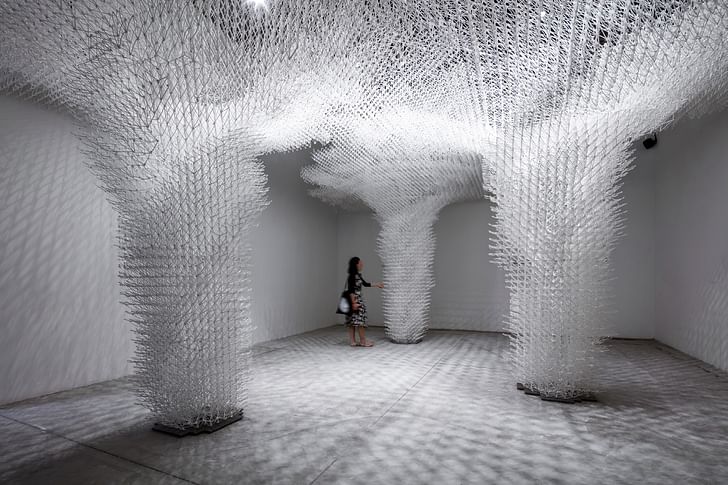

For Alisa Andrasek, a career in architecture represents a point of convergence for her dual passions for art and science. For the past two decades, a respect for both the mathematic and emotional, the computational and the creative, has propelled Andrasek's enthralling investigations into an ecological vision of urbanism.
Describing cities as "the most complex constructs humanity has ever created," Andrasek sees artificial intelligence, computation, and mathematics as a vehicle for delivering urban and infrastructural environments that respect the planet while instilling a sense of "wonder and discovery" in both designers and citizens alike.
In July 2023, Archinect’s Niall Patrick Walsh spoke with Andrasek about her background, her work across academia and practice, as well as her reflections on the relationship between computation, data, and architecture. The discussion, edited slightly for clarity, is published below.
This article is part of the Archinect In-Depth: Artificial Intelligence series.
Niall Patrick Walsh: Could we begin with an introduction to your roles across design and education?
Alisa Andrasek: I've been working for over two decades between academic research, teaching, and my own practice. I'm currently a professor at RMIT University in Melbourne, prior to which I was director of the MArch B-Pro at The Bartlett School of Architecture. I’ve also held positions at the AA’s Design Research Laboratory and at Columbia University over the past twenty years.
Beyond academia, I am a partner of Bloom Games and a co-founder of AI Build, although I would say that my initial practice, Biothing, was instrumental in developing the core ideas and philosophies that I still draw upon today. A couple of years ago, I started my new company AIARCH, which, like my wider career, sits at the convergence of design, computer science, and exponential technologies.

How did this prolific interest in computation begin for you? Did it emerge as a result of your design education, or does it go back further?
In a way, it was both. Growing up in Croatia, I was a ‘geeky’ kid who attended math competitions, was fascinated by quantum physics, and learned computer programming. I studied architecture partly because it satisfied my scientific interests as well as my artistic sensibility. Years later, when I was at Columbia University, I began explicitly using coding in design processes, by which time I was also engaging with my core interests in complex systems. Cities are the most complex constructs humanity has ever created, and yet we often try to resolve urban issues using an outdated ‘business as usual’ approach.
By contrast, I approach built environments as a true complex ecology. In the early 2000s, I began focusing my efforts on what I call the ‘logical core of architecture,’ where I recognized that most systems transforming the world today possess an informational core. Placing information as a 'connective hinge' between different systems allows for increased malleability and flux within built ecologies. Computation and algorithms are my vehicle for designing this informational core. I have been working with generative algorithms for many years and, from the early 2000s, have adopted the analogy of a gardener working with a library of code. Despite operating in this space for years, I am nonetheless excited by recent advancements in AI, which are now becoming a more explicit part of the design process.
Cities are the most complex constructs humanity has ever created, and yet we often try to resolve urban issues using an outdated ‘business as usual’ approach. — Alisa Andrasek

While all of the work I have seen from you has this computational core, you manifest it across many scales. I’ve seen one project of yours dealing with massive landscapes, such as Australian mines, and protostructures such as Cloud Pergola, right down to product design. There is also the fact that you deploy computation not just as a design tool but as a construction tool through robotics and 3D printing. Amidst all of these scales and modes, are there common elements or even a common design process that you deploy throughout your work?
The core of my work is always stable, even though it has continued to evolve over twenty years. Structuring the design process as an open and creative synthesis between relevant agencies, namely systems and determinants, is at the core of my approach. The great pieces of architecture throughout history are an amalgamation of their time, their zeitgeist, and the available technologies. I therefore ask: What could be the architecture of today or tomorrow that resonates with the spirit of our time? For me, it is this kind of ecological thinking, complex synthesis, and open synthesis; processes that, to me, are natural and nascent to architecture.
The great pieces of architecture throughout history are an amalgamation of their time, their zeitgeist, and the technologies that were available. — Alisa Andrasek
Today, this capacity is accelerated through computational resources. My career has been about developing design workflows using computation that could synthesize different elements and read systems from the outside. In the early 2000s, I drew inspiration from quantum physics and particularly wave functions, which today is popularly called parametricism. Very soon, however, I realized that parametric functions are too much of a closed system. Due to their mathematically linear nature, they cannot face complex phenomena.
I therefore started looking for different logical structures. I was drawn to discrete computational structures such as multi-agent systems: Complex adaptive systems that react to their environment rather than being directed from the top down. It is akin to how a school of fish collectively adapts to a shark swimming through them. In computational terms, you have a series of algorithms that are more open to some degree because they are able to read information in their environment. We used multi-agent systems for our solar fields project in Australia, for example, to read various local data and respond with shifting behavioral patterns.

I was reading about how you also used multi-agent systems in Cloud Pergola to ensure that the structure you were building was structurally sound. This goes to your earlier point about addressing complex systems on the micro or macro level.
In mathematics and physics, scientists habitually talk about 'n dimensions,' so, in an analogous way, I think about what the relevant 'n dimensions' are in each of my projects. The behavioral patterns of agents can act as decision-makers in a given system. In Cloud Pergola, the agents' collective behavior was very simple. They perform a spiral ascent to create vertical column fields and, at a certain height, change behavior by establishing horizontal connections and sprawling to connect as a canopy. The spiraling behavior reinforced the structure, but it also produced interesting aesthetic effects. The dynamic behavioral patterns of the agents generated data that, in the design workflow, could be used to make various local decisions or generate beautiful non-linear patterns like those found in natural formations.
Even with just three vectors as inputs, the power of complexity in computation results in a rich output from a minimum input. — Alisa Andrasek
In 2001, when I started teaching code within the design studio at Columbia, it was common to find creative minds who were not naturally drawn to writing code. While searching for methodologies to make the topic more user-friendly, I invented a little exercise that looked at how you could produce interesting results by taking one component with particular connection points and proliferating it. This is how I introduced them to the idea of rule-based systems.
Many years later, in 2012, Jose Sanchez and I applied that logic to Bloom’s urban toy project for the London Olympics. I’ve seen thousands of people playing with that system and have never seen two people generate the same outcome. Even with just three vectors as inputs, the power of complexity in computation results in a rich output from a minimum input.

This brings me to another mathematically derived feature that I deploy in my work: discretization. When you have blanketed linear functions such as parametric wave functions, you are working with algorithms that cannot speak to anything outside of themselves. They aren’t compatible with an ecological premise. By contrast, the power of a discretized system is that the dumber the building blocks, the better. As a collective, they have the capacity to read data from the external environment and self-organize, adapting to those external conditions. This is crucial for an open system.
Frankly, I’ve never seen students adopt technology as fast as they have adopted generative AI. — Alisa Andrasek
Today, we are experimenting with powerful virtual simulation platforms alongside AI and data-enhanced design syntheses. We are working on the automation of various workflows in design, including certain sequences within the creative process along two different tangents.
One tangent is a creative ideation process that incorporates the generative AI tools that many of your readers will be familiar with. Frankly, I’ve never seen students adopt technology as fast as they have adopted generative AI. There is no barrier to adoption, and given the intuitive nature of the tools, students can develop their visual and conceptual thinking skills, and even expand on their imagination, at an incredibly accelerated rate. That said, this tangent isn’t yet translatable into the nuts and bolts of a physical environment.
The second tangent is a mission to synthesize data within a design simulation and then use AI to search within that sea of data to find patterns and discover new possibilities. These two tangents will eventually merge, and I’m working on bridging them, but we are not there yet. We have virtual images on one side, and context-sensitive data of the physical environments on the other.

Going back to your original question about the macro, I am reminded of the large fires that broke out in Australia in 2020. I was in Melbourne at the time, and even though the fires were more than a hundred kilometers away, you couldn’t breathe outside. This caused me to ask: “What is the relevance of my work here? How can I contribute to planetary health? Can we move beyond the development of small-scale, robotically fabricated, high-resolution, and aesthetically interested prototypes, to engage planetary-scale challenges and innovate in systemic large-scale solutions?”
The key is to always maintain a rigorous, quality, focused output in the infinite generative space you are working in. — Alisa Andrasek
My students and I subsequently began exploring topics such as high-density cities co-existing with wilderness in the same space. Here, too, students were able to use generative AI tools such as Midjourney to work on ideation beyond our current imagination. Sometimes, we deployed speculative scenarios, such as high-density living co-existing with massive forests in the same space. Inspiration within projects may come from the parallel realities of quantum physics, or from literature such as China Mieville's City and the City or Kim Stanley Robinson's The Ministry for the Future. Other times, students are grounded in specific territories such as Bangladesh, where they would confront super high-density urbanism along with flooding and other environmental challenges. Even in a short studio format, the projects allow us to look at a multitude of issues simultaneously.
As I mentioned, these projects see students enter into a conversation with AI through hybrid methods. It isn’t about just generating Midjourney images from text prompts. We also use image-to-image functions in Midjourney, or combine ChatGPT with text-to-image; everything becomes part of an ecology. The key is to always maintain a rigorous, quality, focused output in the infinite generative space you are working in.

In preparing for this conversation, I saw some of the outputs of these larger-scale investigations, which really capture the imagination. Could you give us an insight into a couple of projects that stand out?
There are two investigations from these efforts that come to mind. With my company AIARCH, and my research umbrella at RMIT under the topic of the 'Complex City,' we seek to create high-density, high-quality urban environments. Specifically, we looked at a few strategies. One is a process I call 'sculpting by data,' where we start from first principles and ask ourselves which features are desirable in a given typology, for instance, the high-density, multi-unit residential typology. Using various forms of machine learning, we then generate and parse through data, finding patterns that we would not be able to see without the AI enhancement. I entitled this type of the process 'AI combinatorics of space,' which was developed alongside some of my PhD candidates. The question becomes: How do we construct it? What are some of the available and, importantly, scalable forms of construction that we can tap into and rewire through the fabric of computation?
Now, thanks to a merging of human creativity and AI, we can open up a massive world of design possibilities without impacting the cost of design and construction. — Alisa Andrasek
One example of this approach is the 'AI Timber' project. Here, we focus on the combinatorics of timber prefabrication building elements, uncovering an extreme diversity of architectural possibilities out of the same building blocks. This comes again from the basic premise of computation and complexity that we discussed earlier: Minimum input leading to maximum output. This is a vital area of investigation for the wider topic of prefabricated architecture. On one hand, the prefabricated architectural process has for decades offered up boring, repetitive, unloved buildings. But on the other hand, it is an architectural system whose scalability is vital for reducing CO2 emissions. Now, thanks to a merging of human creativity and AI, we can open up a massive world of design possibilities without impacting the cost of design and construction. We can find scalable, systemic, beautiful solutions for a planet that is out of time.

The second area of investigation targets large, systemic infrastructures that always tend to consist of large engineering projects, such as solar farms, devoid of design. We work with context-sensitive data to create something beautiful and smart: A massive-scale canvas in the landscape. A large population of solar panels behaves like a wild forest, adapting to site-specific considerations such as topographic features or wind and solar exposure patterns. It isn’t purely about raw energy production. We might not be able to achieve 100% efficiency, but with this designed infrastructure, maybe we can achieve 70% efficiency while also creating a destination that people will actively seek out: One that amplifies the site rather than simply exploiting it.
We work with context-sensitive data to create something beautiful and smart: A massive-scale canvas in the landscape. — Alisa Andrasek
There’s no shortage of ambition in these projects. The challenge I often encounter, and which many in this AI space encounter, is computing power. There are powerful supercomputers out there, but that kind of infrastructure can cost tens or hundreds of thousands of dollars per month to use. The faster that commercial computing power advances, the more ambitious yet intricate our processes can become. There is also the necessity for cross-disciplinary teams for tackling these complex polymathic challenges.

Considering all of these engagements of yours in design, urbanism, and computation, I’m curious to hear your views on the longer-term future relationship between humans and artificial intelligence in the design process.
Obviously, this is a complex question with many variables. What I have observed on a smaller scale working with generative design is that AI introduces a new method for humans. I mentioned the gardening metaphor earlier, and that is indeed what it feels like. We are like gardeners, cultivating this data landscape that we cannot entirely control, although we can definitely encourage certain behaviors or outcomes. It is, therefore, a collaborative, enhanced design process between humans and machines.
We should certainly be working with it. There are plenty of problems to address in the world and plenty of space for creativity to evolve. As I said earlier, the power of architects is complex synthesis: The ability to comprehend and bring together various determinants within a complex, synthetic structure. There is still a mountain of work for us as human architects. We have an outdated and unsustainable business model, so I am trying to automate as many laborious tasks as I can and create this digital partner that can enhance our work.
We are like gardeners, cultivating this data landscape that we cannot entirely control, although we can definitely encourage certain behaviors or outcomes. — Alisa Andrasek
If there is one thing that bothers me about AI tools, particularly generative AI such as Midjourney, it is that after a while, the images all look the same. That said, we and quite a few others in the design community are evolving these tools and developing more specific and customized versions of them, where AI can resonate with the particular sensibilities of the human designer, whether they are living or historic. AI has incredible synthetic capacities that can evoke a special quality often seen as the exclusive purview of humans: Something that gives you the “wow” moment that is so important to human aspiration. This is why I called my research lab “Wonderlab,” to emphasize this sense of wonder and discovery.
Niall Patrick Walsh is an architect and journalist, living in Belfast, Ireland. He writes feature articles for Archinect and leads the Archinect In-Depth series. He is also a licensed architect in the UK and Ireland, having previously worked at BDP, one of the largest design + ...
No Comments
Block this user
Are you sure you want to block this user and hide all related comments throughout the site?
Archinect
This is your first comment on Archinect. Your comment will be visible once approved.